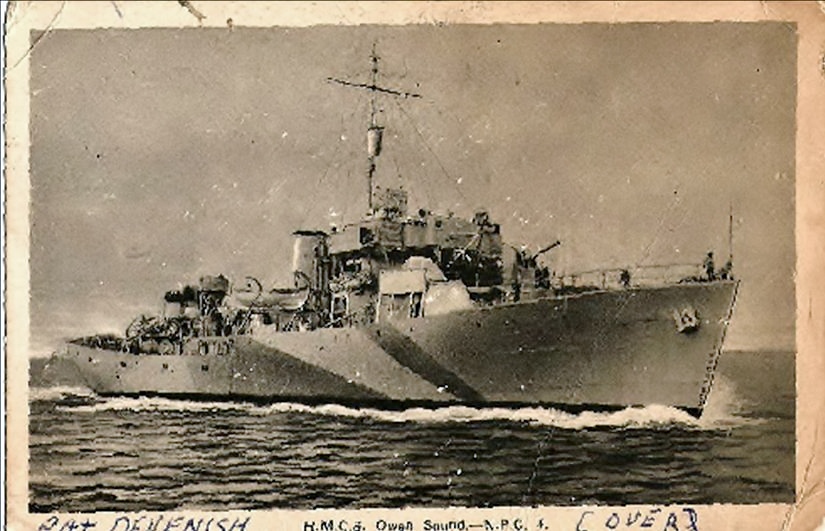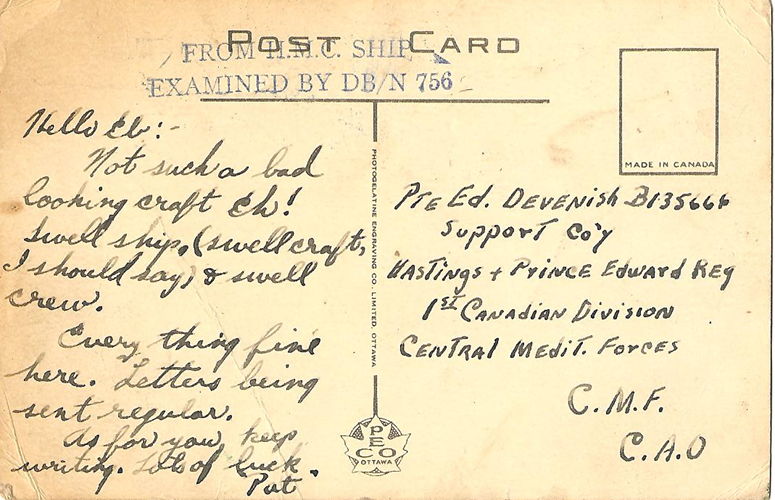
SUBMITTED
Two brothers’ wartime service
By CPO1 (ret’d) Patrick Devenish
Canadian Naval Memorial Trust
Editor’s note: CPO1 (ret’d) Patrick Devenish usually writes about Royal Canadian Navy history, and Second World War history. In the following article, he has chosen to share some of his family history: specifically, that of his Uncle Pat Devenish. Thanks to an email from his cousin, CPO1(ret’d) Devenish was able to learn more about his uncle’s wartime service in the Royal Canadian Navy.
The following is an email from my cousin Greg Devenish in the summer of 2010, relaying to me a story from his dad. His Dad was Charles Patrick Devenish. For whatever reason, his own family referred to him as Charles but all us cousins knew him as Uncle Pat. Dad passed away June 26, 2000 and Uncle Pat passed away around 2006.

“Hello Patrick.
Dad joined the RCN in 1942. He completed his training at Cornwallis in Nova Scotia and became a Signal-man. This allowed him access to the bridge and Asdic hut. His first ship was the corvette, HMCS Owen Sound, which was a new increased endurance corvettes and thus slightly larger than the earlier Flower class built earlier in the war. HMCS Owen Sound was built in Collingwood, Ontario and completed in October 1943. The ship was attached in December 1943 to escort group EG9. EG9 consisted of the frigates HMCS Swansea, and Matane and the corvettes HMCS Baddeck, Atholl , North Bay, Frontenac and Owen Sound. This escort group was placed on the run from Halifax to Londonderry, Northern Ireland (minus Atholl). EG9 was declared operational and began escorting convoys in February 1944.
While escorting SC154 (Slow (out of Sydney) Convoy 45 ships). Owen Sound was sailing with HMCS Halifax (Corvette) and St. Laurent (River Class Destroyer) on March 8th. St. Laurent and Owen Sound were assisting the freighter San Francisco which was experiencing boiler fires. U-boat transmissions had been heard and crews were on alert. Further ahead HMCS Assiniboine and HMS Forester were detecting U- boat transmissions. St. Laurent was the first to spot the surfaced U-845 (type IXc) trailing the main convoy. Owen Sound and St. Laurent charged the U-Boat while Halifax was ordered to stay with the stricken freighter. Owen Sound placed an accurate depth charge as did St. Laurent. Unfortunately Owen Sound’s electric system failed due to depth charges exploding. St. Laurent pressed home its attack and was joined by Swansea and HMS Forester. U-845 surfaced after over 5 hours of depth charging and was raked by 20mm oerlikons as well as 4” main armament. The submarine opened its flooding valves and the crew abandoned the submarine at 11:38 p.m. Forty-five survivors were picked up. Captain Weber of U-845 died by gunfire. The Admiralty wrote “We congratulate HMS Forester, HMCS St. Laurent, HMCS Owen Sound and Swansea on the destruction of a U-boat on 10th of March 1944.” The captain of Swansea sent a telegram to Owen Sound (perhaps dad got this message because he was on the bridge. “ A real nice piece of work –Thank You”.
Dad would later serve on River class frigates HMCS Stormont and HMCS Stettler.
Dad (Ed Devenish) was called Ebby by his siblings. He served in a 3” mortar platoon in the Hastings and Prince Edward Regiment as part of the First Canadian Infantry Division which was attached to the British Eighth Army.
On land (8th Army) – In July 43, the Allies invaded Sicily, securing the island in mid – August. Following the invasion of the Italian mainland in Sept 43 and even though Italian forces surrendered September 7/43, the fight there against the German Army would last until the closing months of the war. The Italian campaign was climaxed for Canadian forces during Christmas 1943 at the Battle for Ortona. Such was the carnage that the battle was given the ominous moniker “Little Stalingrad”.
In the Atlantic, though the “Happy times” for the German U-boat fleets had passed, wholesale slaughter was still occurring on the Atlantic convoy routes. This was also the period of time when the German submarines introduced the use of the deadly acoustic torpedo. Torpedo firings were no longer hit or miss. Though Owen Sound was new to Uncle Pat (commissioned in Collingwood, Ontario November 17, 1943), he would learn the ropes and go on to later serve on the frigates Stormont and Stettler as well. This postcard was likely sent around Christmas 1943 as Owen Sound prepared for crew workups.






